This article needs additional citations for verification .(June 2014) |

The scheitholt or scheitholz is a traditional German stringed instrument and an ancestor of the modern zither. It falls into the category of drone zithers.
This article needs additional citations for verification .(June 2014) |

The scheitholt or scheitholz is a traditional German stringed instrument and an ancestor of the modern zither. It falls into the category of drone zithers.
The scheitholt may have derived from an ancient Greek instrument for theoretical education in music and physics, the so-called monochord (an oblong wooden box with only one string). Scheitholt originally referred to logs split into firewood or Scheitholz (Scheit = piece, chip; Holz or Low German Holt = wood). Since the 16th century, the instrument was called by that name, presumably because it had a similar shape or size. The best known description of this instrument is by Michael Praetorius in 1619. A number of regional names for the instrument exist. In northern Germany the instrument is often called hummel , meaning "bumble bee" (a reference to the humming sound of the drone strings—the same word was also used for the bagpipe). Other names include the Dutch noordse balk, French bûche or bûche de Meuse, Flemish vlier and Swiss German Hexenscheit. [1]
In the Bavarian/Austrian region, the scheitholt can be traced back to the 14th century. Similar instruments are found in other parts of Northern Europe; in America, the scheitholt was probably brought to Pennsylvania by German settlers and spread into the Appalachian mountain region, where it later evolved into the Appalachian dulcimer in the late 18th century. The Appalachian dulcimer (or mountain dulcimer, or lap dulcimer), is a scheitholt fingerboard mounted on a larger sound box. [2]
The original scheitholt usually consisted of a wooden soundbox about 50 cm (19.7 in) long and 5 cm (2 in) wide, with a simple headstock and two or three strings. Besides brass, these strings were often also made of simple materials such as animal hairs, gut or waxed linen. There is no fingerboard but there are wires which are set in the wood under the strings as frets. Beginning in the 16th and 17th centuries, the scheitholte had three to four strings. In the further development the size of the soundbox was increased, and an independent fingerboard was glued on. From the scheitholt with a change of form the kratzzither or scherrzither developed around the mid-18th century.
The Scheitholt was played similarly to the modern zither. It was placed horizontally on a table or on the player's lap, the left hand pressed the strings with a wooden stick sometimes called a 'noter', while the thumb and index finger plucked the strings either directly, or with a horn or wooden plectrum, or with a goose quill. Some strings functioned as drones.
The scheitholt and/or hummel was played throughout the 19th century in the alpine regions in south Germany. Northern Germany, in the Erz Mountains of Saxony and in the Oberlausitz. [3]
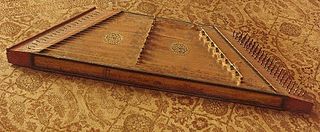
The word dulcimer refers to two families of musical string instruments.

In musical instrument classification, string instruments or chordophones, are musical instruments that produce sound from vibrating strings when a performer plays or sounds the strings in some manner.

The crwth, also called a crowd or rote or crotta, is a bowed lyre, a type of stringed instrument, associated particularly with Welsh music, now archaic but once widely played in Europe. Four historical examples have survived and are to be found in St Fagans National Museum of History (Cardiff); National Library of Wales (Aberystwyth); Warrington Museum & Art Gallery; and the Museum of Fine Arts, Boston (US).

Zithers are a class of stringed instruments. Historically, it could be any instrument of the psaltery family. In modern terminology, it is more specifically an instrument consisting of many strings stretched across a thin, flat body, the topic of this article.

A psaltery is a fretboard-less box zither and is considered the archetype of the zither and dulcimer. Plucked keyboard instruments such as the harpsichord were also inspired by it. Its resonance box is usually trapezoidal, rectangular or in the form of a "pig's head" and often richly decorated.

The langeleik, also called langleik, is a Norwegian stringed folklore musical instrument, a droned zither.

The Appalachian dulcimer is a fretted string instrument of the zither family, typically with three or four strings, originally played in the Appalachian region of the United States. The body extends the length of the fingerboard, and its fretting is generally diatonic.
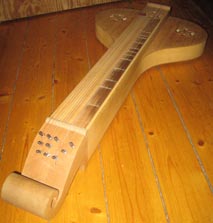
The hummel is an old Northern European stringed instrument similar to an older type of zither and is related to the Norwegian langeleik. The name is thought to come from the German word Hummel, meaning "bumblebee", referring to the droning sound created by the accompaniment strings.
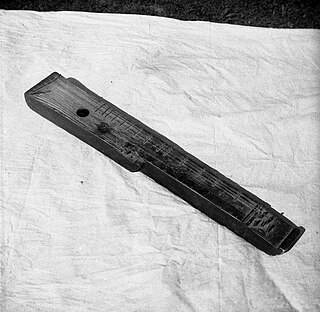
Drone zithers or droned zithers are stringed instruments of the zither family that have few melodic strings and a greater number of drone strings. The oldest known form of drone zither is the Scheitholt.

The jouhikko is a traditional, two- or three-stringed bowed lyre, from Finland and Karelia. Its strings are traditionally of horsehair. The playing of this instrument died out in the early 20th century but has been revived and there are now a number of musicians playing it.
The leiqin is a Chinese bowed string musical instrument.

The khim is a stringed musical instrument derived from the Mesopotamian or Persian Santur. It is similar to the Hammered Dulcimer or Cimbalom. This khim was introduced to Thailand from China, where a similar instrument is called yangqin, and introduced to Laos and Cambodia from Thailand later. It is played with two flexible bamboo sticks with soft leather at the tips to produce a soft tone. This instrument can be played by either sitting down on the floor with the khim on the floor, or by sitting on a chair or standing while the khim is on a stand. The khim produces a bright and expressive sound when played. It is made of wood, with brass strings that are laid across the instrument. The Australian-born musician and vocal artist Lisa Gerrard specialises in the use of a khim hammered dulcimer, featuring its music on several albums and performing with the instrument live on tour.
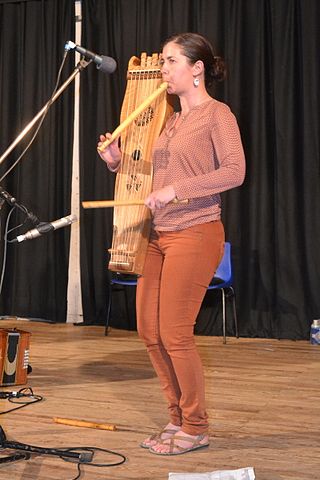
The string drum or Tambourin de Béarn is a long rectangular box zither beaten with a mallet. It is paired with a one-handed flute with three finger holes, similar to a pipe and tabor. It has also been called tambourin de Gascogne, tambourin à cordes in Catalan, Pyrenean string drum, ttun-ttun in Basque, salmo in Spanish, and chicotén in Aragonese. It was known in the middle ages as the choron or chorus.
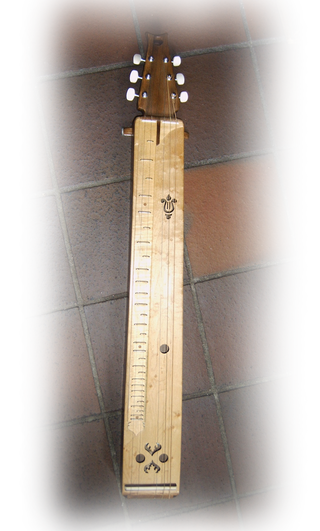
The épinette des Vosges is a traditional plucked-string instrument of the zither family, whose use was confined to two areas in the Vosges mountains of France approximately 50 km apart: around Val-d'Ajol and around Gérardmer.
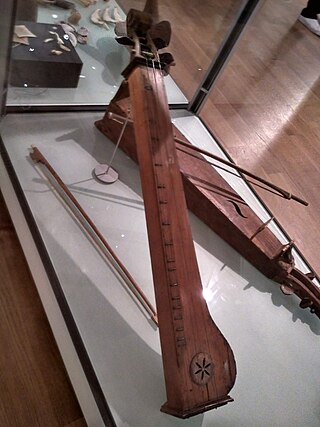
The langspil is a traditional Icelandic drone zither. It has a single melody string and usually 2 drone strings.
The bowed dulcimer is a musical instrument. Designed in the style of the Appalachian dulcimer, it is either a standard instrument played with a violin bow, or a purpose-built dulcimer designed around bow playing. The purpose-designed instrument is described as resembling a hybrid between a dulcimer and a cello or viola da gamba.

The tube zither is a stringed musical instrument in which a tube functions both as an instrument's neck and its soundbox. As the neck, it holds strings taut and allows them to vibrate. As a soundbox, it modifies the sound and transfers it to the open air. The instruments are among the oldest of chordophones, being "a very early stage" in the development of chordophones, and predate some of the oldest chordophones, such as the Chinese Se, zithers built on a tube split in half. Most tube zithers are made of bamboo, played today in Madagascar, India, Southeast Asia and Taiwan. Tube zithers made from other materials have been found in Europe and the United States, made from materials such as cornstalks and cactus.

The Streichmelodion or Breitoline is a bowed zither, similar in shape to a viola. The Streichmelodion was created in 1856 by Leopold Breit in Brno, evolving from the alpine zither and inspired by the Streichzither. The Breitoline is described as having a richer, more robust tone than the Streichzither, and has a compass slightly lower than that of a viola. Breitolines are played with the body of the instrument resting on the player's lap, with the part of the zither between the neck and headstock resting on a table. Many Streichmelodions were produced in Markneukirchen at the Ernst Rudolph Glier factory during the 19th century.